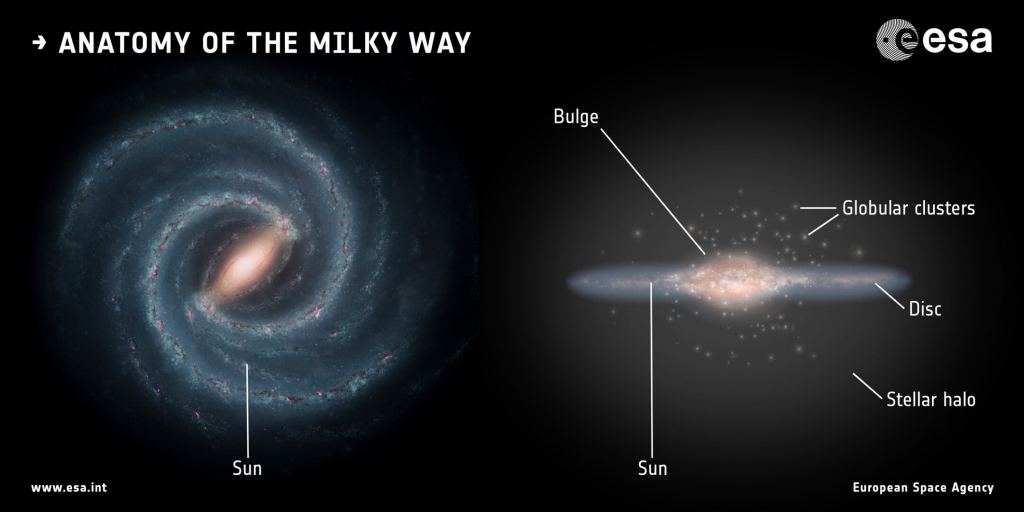Gaia Finds Ancient Streams of Stars That Formed the Milky Way
Using ESA’s Gaia spacecraft, astronomers have tracked down two streams of stars that likely formed the foundation of the Milky Way. Named “Shakti and Shiva,” the two streams contain about 10 million stars, all of which are 12 to 13 billion years old and likely came together even before the spiral arms and disk were formed. These star streams are all moving in roughly similar orbits and have similar compositions. Astronomers think they were probably separate galaxies that merged into the Milky Way shortly after the Big Bang.,
“What’s truly amazing is that we can detect these ancient structures at all,” said lead author Khyati Malhan of the Max Planck Institute for Astronomy (MPIA) in Heidelberg, Germany, in an ESA press release. “The Milky Way has changed so significantly since these stars were born that we wouldn’t expect to recognize them so clearly as a group – but the unprecedented data we’re getting from Gaia made it possible.”
Astrometry Data
Gaia uses astrometry — the precise measurements of the positions and movements of stars and other celestial bodies – and is building the largest, most precise three-dimensional map of our Galaxy by surveying nearly two billion objects.
With Gaia’s data, the researchers were able to determine the orbits of individual stars in the Milky Way, as well as determine their content and composition. These ancient stars are all moving in very similar orbits and the structure of the two different star streams stood out because their stars contained a certain chemical composition.
“Shakti and Shiva populations possess an unconventional combination of orbital and abundance properties that have not been observed previously,” the researchers wrote in their paper, published in the Astrophysical journal.
By compiling very detailed chemical abundance patterns for each, the astronomers determined these stars were the oldest stars in the galaxy, all born before the disc of the Milky Way had formed.

“The stars there are so ancient that they lack many of the heavier metal elements created later in the Universe’s lifetime,” said co-author Hans-Walter Rix, also of MPIA and the lead ‘galactic archaeologist’ in this research, which began in 2022. “These heavy metals are those forged within stars and scattered through space when they die. The stars in our galaxy’s heart are metal-poor, so we dubbed this region the Milky Way’s ‘poor old heart’. Until now, we had only recognized these very early fragments that came together to form the Milky Way’s ancient heart. With Shakti and Shiva, we now see the first pieces that seem comparably old but located further out. These signify the first steps of our galaxy’s growth towards its present size.”
While the two streams are similar, they aren’t exactly the same. Shakti stars orbit a little further from the Milky Way’s center and in more circular orbits than Shiva stars. The streams are named two divine beings from Hindu philosophy who worked together to create the Universe.
Because of Gaia’s ability to provide data to create incredibly detailed celestial maps, the researchers were able to build a dynamical map of that includes the two star streams plus other known components that have played a role in our galaxy’s formation.
“Revealing more about our galaxy’s infancy is one of Gaia’s goals, and it’s certainly achieving it,” said Timo Prusti, Project Scientist for Gaia at ESA. “We need to pinpoint the subtle yet crucial differences between stars in the Milky Way to understand how our galaxy formed and evolved. This requires incredibly precise data – and now, thanks to Gaia, we have that data. As we discover surprise parts of our galaxy like the Shiva and Shakti streams, we’re filling the gaps and painting a fuller picture of not only our current home, but our earliest cosmic history.”
Further reading:
ESA press release
Paper: Shiva and Shakti: Presumed Proto-Galactic Fragments in the Inner Milky Way
The post Gaia Finds Ancient Streams of Stars That Formed the Milky Way appeared first on Universe Today.
Universe Today
Go to Source